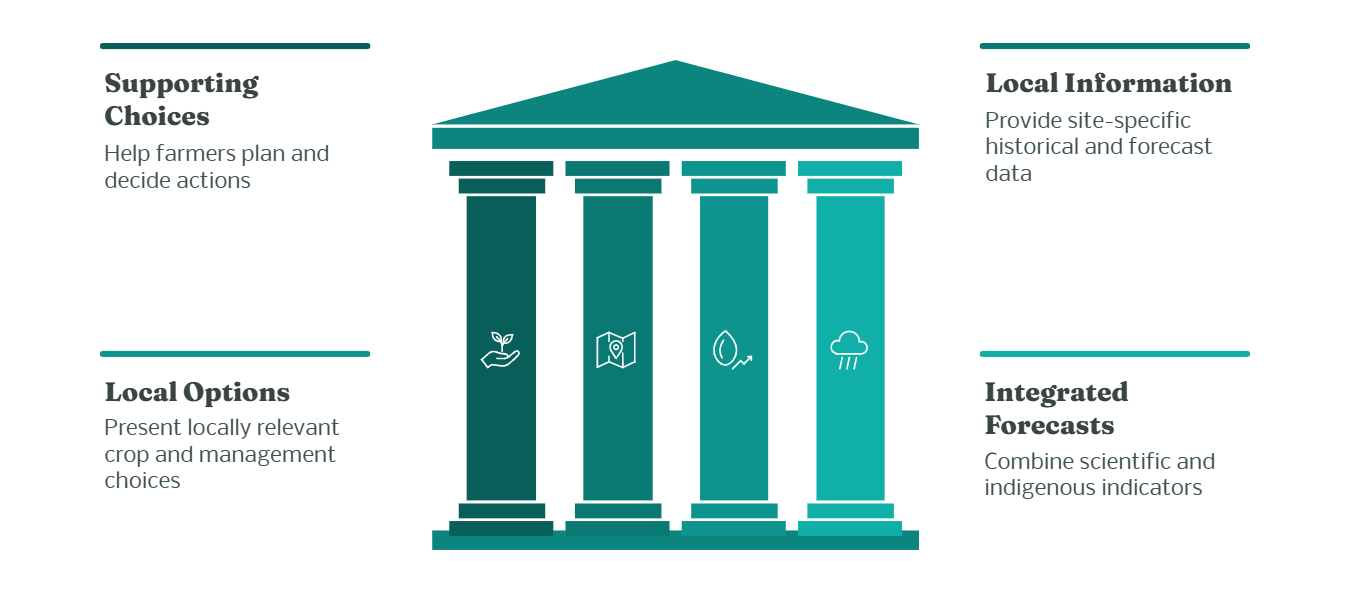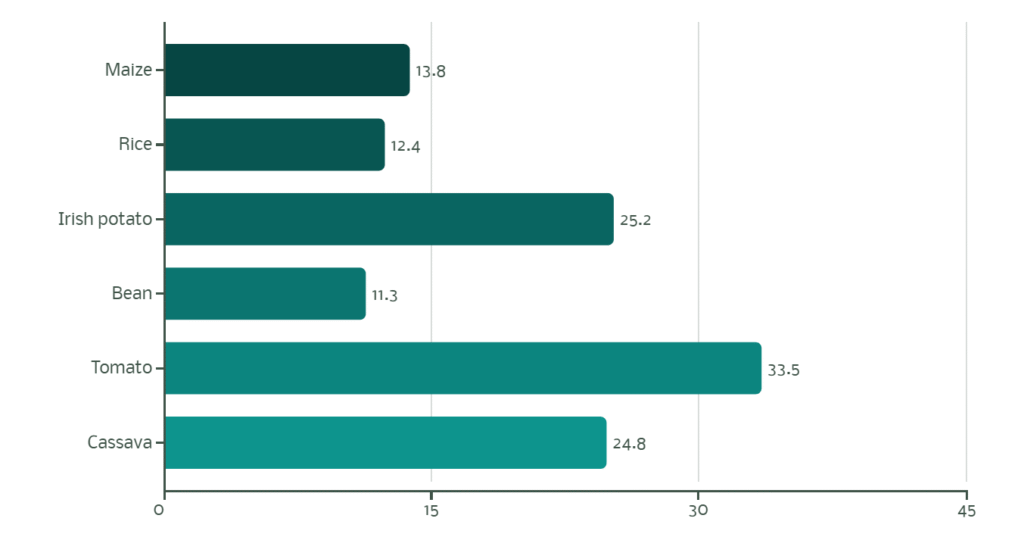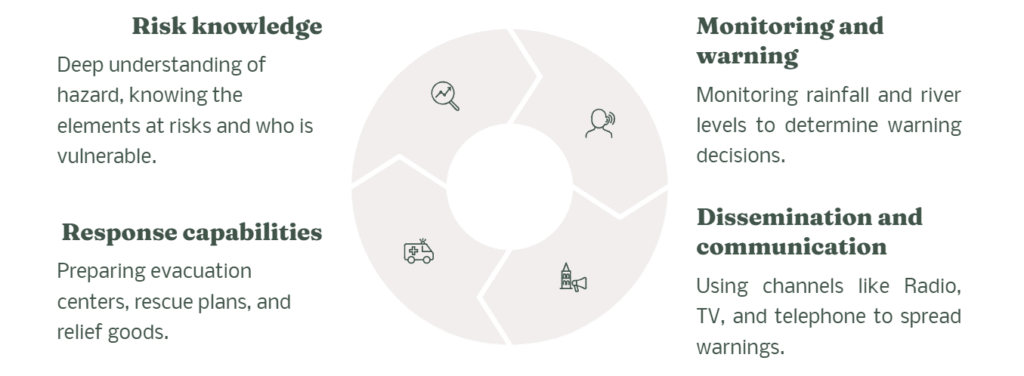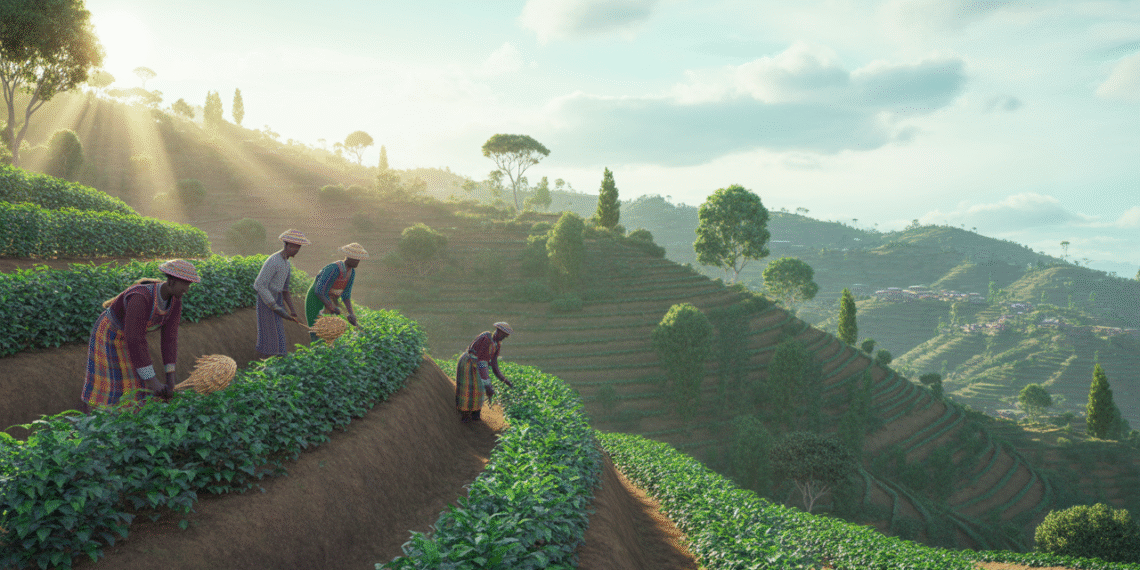1st Edition Weather information tools for Smallholder farmers
Frank Mutesa
Rwanda Agriculture and Animal Resources Development Board
Uwera Amina
Famu’s Co. Ltd, Rwanda
RESEARCH ARTICLE
This article is part of a special issue titled Bridging Power and Knowledge: Addressing Global Imbalances in Knowledge Systems for Sustainable Futures.
PLAIN-LANGUAGE SUMMARY
WATCH A SUMMARY OF THE ARTICLE
LISTEN TO THE PODCAST
Abstract
Smallholder farmers in Rwanda face significant challenges from increasing climate variability, including unpredictable rainfall patterns, droughts, and floods, which severely impact agricultural productivity and food security. This research article explores the critical role of accessible and accurate weather forecasting information in enhancing farmers’ resilience and decision-making capabilities. Focusing on services provided by Meteo-Rwanda, this study investigates how the integration of scientific meteorological data with indigenous knowledge forecasting methods creates a more robust and locally relevant early warning system. By combining modern meteorological tools with traditional indicators, these services offer tailored forecasts that empower farmers to make timely decisions regarding planting, harvesting, and crop management. The implementation of these localized weather information systems has led to documented benefits, significantly improving agricultural outcomes. Specifically, farmers utilizing these integrated forecasting services have reported a 15-25% improvement in crop yields, contributing substantially to enhanced food security and livelihoods. This paper highlights the effectiveness of a hybrid approach to weather information dissemination, advocating for similar strategies in other climate-vulnerable agricultural communities.

Keywords: Smallholder farmers, Rwanda, Weather forecasting, Climate variability, Crop yields
Introduction
Smallholder farmers in Sub-Saharan Africa face significant crop losses due to insufficient weather and climate information. Their intensive farming efforts are often wasted when weather patterns deviate from expectations. Notably, 70% of smallholder farmers in Africa depend on rainfed farming systems (Sciencedirect, 2024). This makes understanding weather patterns crucial for smallholders, who suffer disproportionately from irregular climate changes (Clark et al., 2003). Climate change is a primary driver of crop loss for these farmers (Challinor et al., 2007), with projections indicating that it will cause a 5-10% reduction in rural household consumption by 2050 in Rwanda (CGIAR research). However, those who access and utilize weather and climate information achieve better harvests and improved planning, compared to those lacking climate adaptation and mitigation knowledge. Weather forecasting enables smallholder farmers to properly prepare and plan farm operations such as planting, irrigation, fertilizer application, pruning/weeding, and harvesting. The government of Rwanda actively promotes climate change information for agricultural activities. Through the Participatory Integrated Climate Services for Agriculture (PICSA), Rwanda was the first country to train all district agronomists in climate services. Developed and tested by the University of Reading, PICSA is a farmer-centric approach that equips smallholder farmers with knowledge to make informed decisions about their agricultural practices based on local weather and climate information. This approach is built around four key elements:
Supporting farmers’ choices
Supporting farmers to make their own choices and plans.
Providing local information
Making availability of locally specific historical and forecast information and the tools to interpret them.
Considering local options
Facilitating the consideration on a range of locally relevant options on crop, livestock, livelihood and their specific management practices.
Participatory tools
A set of participatory decision-making and planning tools which help farmers to identify options that are most suitable for them.
Smallholder farmers are highly vulnerable to climate change risks and negative impacts. They must recognize that their actions are vital for survival. Understanding weather and climate information is paramount for wise planning, tailored to local conditions. For instance, a study revealed that 85% of farmers in Rwanda’s Eastern Province acknowledge climate change, with 54% observing temperature increases (Rwema et al., 2025). This document aims to guide farmers on accessing reliable weather and climate forecasts and effectively using this information in their daily work. Increased engagement in monitoring local weather empowers smallholder farmers to make informed agricultural decisions, such as selecting crops, adapting cropping systems, or even opting for off-farm activities during unsuitable seasons, depending on their planning in the face of a changing climate.
WEATHER FORECASTING INFORMATION
Background to Weather forecast in Rwanda
Livelihood and agriculture activities in Rwanda have been increasingly threatened by the changing climate and pose severe changes in food security and economic stability. Given that agriculture accounts for 25% of Rwanda’s GDP and provides livelihoods for over 80% of the population (NISR, 2020), these threats are particularly severe. Smallholder farmers in Rwanda have been suffering from climate shocks for years. These threats include, for instance, documented temperature increases of +0.76°C/decade for minimum temperatures and +0.48°C/decade for mean temperatures (Rwema et al., 2025), alongside prolonged drought and erratic rainfalls, which interrupted farming circles in some regions, and contributed to crop yield failures and soil degradation. Looking at the topography of the country, which is mountainous, and the level of understanding of farmers regarding weather and climate information, if there are no measures to mitigate and adapt to these shocks then the severity level will keep on increasing. However, nowadays farmers have access to much more information on weather and climate due to increased concern from different institutions. This has raised awareness among scientists, who in turn have developed strategies and ways to disseminate information to farmers. Meteo-Rwanda is at the forefront in providing weather and climate information in the form of weather events, which could be the amount and time of rainfalls, temperature levels, wind speed, humidity, and provides warnings for extreme weather events like floods, droughts, and strong winds on a daily and monthly basis. This has been of great help to the communities and especially farmers in their agricultural activities.
The issue remains, how do smallholder farmers get the information from? Do they know that these weather forecasting information exists in the first place? And if yes, how often do they use the information?
Sources of weather information
In Sub-Saharan Africa, where most of the farmers are rain-fed dependents, weather information is most useful to them and can be communicated from the agencies responsible through different channels, which include:
The increasing daily SMS subscriber numbers for weather information in Rwanda (CGIAR research) further demonstrate the growing reach and impact of these dissemination efforts.
The useful information that are broadcasted through these communication channels by Meteo-Rwanda are used by the whole communities and groups of people from the business people all the way to farmers, from public to researchers. They issued also the specialized forecasts for agricultural activities including information on crop selection, sowing and harvesting date, pest and diseases outbreak, and the early warnings for severe weather events, which will help farmers to plan accordingly and other disaster management agencies to mitigate and minimize threats and impacts.
Rwanda meteorological agency, collects and process data from different sources, from manual and automatic weather stations, radar data and satellite imagery and process the data collected using software like Climsoft in managing and archive the data in a Meteorological Databank. These data are used to generate climate and weather forecast and warnings. Through the data extracted and analysis from RAB (Rwanda Agricultural and animal resources Development Board), it is said that climate change and its related factors affect Rwandan agriculture by reducing production every year. The estimated percentage reduction in yield for key crops is illustrated below in Figure 1.

Figure 1: Estimated crop production reduction due to climate change in Rwanda (%).
Purpose and the importance of weather forecasts
Weather forecasting information is not just for the farmers, but all the stakeholders in agricultural sector. These are useful information that will enable them to make decisions in the context of an increasingly variable climate. Smallholder farmers and other agricultural extension agents need to build and understand social dimensions that influence farm level decision making. The role of the smallholder farmers is to know two key ingredients that are within the whole idea of using in an effective way weather information, which are the integration of weather forecasts and the decision making. The climate change era that the world is passing through, need more data that are within the weather forecasting information which will address an environmental and socio-economic issues. Climate and weather forecasting information also works in health management, whereby, individuals with health conditions like allergies or asthma, who are sensitive to weather changes, to use the information for effective preparation to their health condition and manage their symptoms. So many benefits that are brought by knowing and predicting weather forecasting, be it economically, socially and environmentally. Farmers use these weather forecasting information in planning ahead some of their activities like, the optimum planting by choosing different types of crop varieties and cultivation systems due to different rainfall patterns, harvesting, as well as irrigation schedules, all of which will maximize crop yields and minimize losses due to unexpected weather.
Justification for using weather forecasting information
Irregular weather parameters expose farmers especially smallholder farmers in Rwanda to multiple uncertainties which compromise food and water security, income and wealth. The application of weather forecasting information is still limited to many smallholder farmers and this accelerate the danger to poverty and food insecurity that are caused by the negative impacts of climate change. Two main constraints being;
The work of Meteo- Rwanda has been a tremendous one because it can disseminate weather forecast in a day to day basis. These information are channeled through radio and TVs channels, and there are ways to SMS subscribing that people register and receive the information directly to their mobile phones. This direct method of communication facilitates farmers in utilizing the data effectively for their planning. Figure 2 shows weather forecasting information and its uses in agriculture.

Figure 2: Weather forecasting information and its uses in agriculture
Weather forecast and climate information not only give farmers information but it should focus on the interpretation and providing proper and effective advices which meet their needs. Weather forecasting for farmers is always focusing on the level of rainfalls and its occurrences and the temperature regarding drought period. With the help of Meteo- Rwanda, CIAT, RAB and Radio Huguka, all together we have had series of trainings conducted to different farmer promoters (FPs), using PICSA approach, were these FPs were trained on how to interpret the weather and climate data and plan their agricultural and off-farm activities based on the information fetched from weather and climate forecasting. There are various weather and climate information services that are provided by Meteo-Rwanda which can be accessed by farmers and other stakeholders, which include;
- Monthly climate outlook which report temperature and rainfall variability on a monthly basis
- Daily weather forecasts which outline predictions on temperature and rainfall variability to farmers on a daily basis,
Figure 3 provides an illustration of the rainfall variability experienced throughout the year, which serves as a foundational component for various climate information services:

Figure 3: Rainfall variability on a monthly basis
As illustrated in Figure 3, the rainfall variability throughout the year provides the foundation for several key weather information services:
- Seasonal climate outlook which gives information on the rainfall seasons in a year. This information entails predictions on expected temperature, crop performance, rainfall onset and cessation dates and their distribution throughout the season.
- Climate alerts which are also known as early warning. The information here include floods and drought and the associated impacts based on the previous events.
The information above is vital for Rwandan farmers. While the exact number accessing weather forecasting is not fully documented, a 2024 survey published by Frontiers in Climate suggested that around 69% of 100,000 surveyed farmers access forecasts, indicating a significant increase in beneficiaries of Meteo-Rwanda services. However, many smallholder farmers combine this with indigenous/traditional knowledge. This traditional knowledge is built from observing natural indicators over time and is used for decision making in (1) Agriculture activities, (2) Medicine, (3) Food production and preservation, and (4) Soil and water management. The natural indicators these traditional practices are based on include observation of the following:
- Clouds, moon and stars,
- Behaviors of animal and insects
- Flowering ad shedding of leaves,
- Strength of the wind.
The behavior of the above natural indicators, some can related to the scientific explanations and others say that they are, grounded in a cultural narratives and community- based epistemologies. However, due to highly variable climate changes over the years, smallholders have lost confidence in indigenous forecast and hence seek scientific seasonal forecasting for climate change adaptation and mitigation. With the experience, it has shown that both scientific and traditional forecasts have their strengths and weakness, and thus the combination of both types of information are recommended to increase the adaptation and mitigation to climate change. According to the study conducted by Emmanuel Nyadzi et al, 2022, towards weather and climate services that integrate indigenous and scientific forecasts to improve forecast reliability and accepted in Ghana. They found out that, the majority of the farmers (93%) prefer the Integrated Probability Forecasting (IPF) method, as it provides a reliable forecast, requires less time and the same time resolves the contradictions arising from forecast information from different sources. Due to the effectiveness and accuracy of the IPF method, farmers already integrate the indigenous and scientific forecasts to make farming decision.
EARLY WARNING SYSTEM AND TOOL
What is an early warning system?
If we simplify for the smallholder farmers, the term early warning systems (EWS), as defined by UN, EWS, are the adaptive measures and a warning system for climate change that can be implemented, using integrated and chain of information communication to help communities prepare for hazardous climate- related events (UNEP, 2022) These chains of information communication, comprises of sensors event-detection and decision-making systems for early identification of hazards. The early warning systems are very important in the communities in these changing climate eras, because, it can work in various advantages including;
- Saves lives and jobs
- Land and infrastructures
- Support long-term sustainability
- Saving money in the long run and protect community finances
- Helps in proper planning
Early Warning Systems (EWS) are crucial for agriculture, providing farmers with timely, useful information to understand threats, prepare, and act effectively to minimize losses (Reid et al., 2009). The key elements of an early warning system are:
- Risk knowledge
- Monitoring and warning services
- Dissemination and communication and
- Response capability
These four interdependent elements form a continuous cycle necessary for effective EWS implementation, as Figure 4 illustrates the four elements of the Early Warning System below:

Figure 4: Four elements of the Early Warning System (EWS) as adapted by the United Nations, 2006Figure 4: Four elements of the Early Warning System (EWS) as adapted by the United Nations, 2006
According to the National Institute of Statistics of Rwanda (NISR, 2020), over 76% of the population relies on subsistence agriculture. Although early warning communication channels are established across most districts and sectors, smallholder farmers still face challenges accessing and utilizing this information for effective response. Meteo Rwanda, the national institution mandated to provide accurate, timely weather and climate information and products, serves as the main source for EWS. Highly efficient and customer-focused, Meteo Rwanda channels this information, gathered from approximately 39 weather stations distributed across all four provinces and Kigali City (including low lands, high land, forest, and volcanic areas). Supplementing station data, sophisticated modern systems utilize SMS, emails, and apps to alert communities about potential flood and other risks, thereby aiding farmers and stakeholders in better preservation of their crops and livelihood.
Channels or types of Early Warning Systems
There are different early warning systems that are used to disseminate different alerts in Rwanda (United Nations Environment Programme, n.d.), some are here mentioned;
- SMS
- TV Broadcast
- Radio Data Service
- Local meetings and alerts from village level (Umudugudu)
All of these are to help people and in this case, mostly farmers, to prepare in advance for extreme weather. In Rwanda the warning network has been successful (United Nations Environment Programme, n.d.) because each day the number of SMS subscribers are increasing. More farmers are being trained to monitor and utilize rainfall data to inform agriculture activities (Nyasimi et al., 2016). Depending on the data from Meteo –Rwanda, like when the information is about high rainfall or long period of drought, then farmers are advanced to what and how? The most commonly used climate information for farmers are seasonal forecast of onset of rains, total amount of rainfall, and cessation of rains (Nyasimi et al., 2016), as summarized in the table below in Table 1.
Table 1: The most common used weather and climate forecasts information for farmers
| Weather Forecasting information | Meaning | Farmer use |
|---|---|---|
| Seasonal forecast of onset of rains | The prediction of the rain season, when it likely to begin and in a specific area or region | Land preparation, which crop to plant and farm management |
| Total amount of rainfall | The accumulated depth of rain water over a specific area in a specified area. Measured in millimeters | planning for different agriculture system, crop selection and farm management |
| Cessation of rains | End of rainfall period and a transition to drier period | Agricultural planning, when to plant or harvest and water resource management |
EVIDENCE OF IMPACT: Research Findings on Climate Services Effectiveness
Intergenerational Dynamics of Volunteering
Understanding the tangible impact of climate services is crucial for their continued adoption and improvement. Research findings from various initiatives highlight the significant benefits and successful implementation strategies, particularly in regions like Rwanda and across Sub-Saharan Africa. These findings provide evidence of how climate services empower farmers, enhance agricultural resilience, and contribute to broader development goals.
PICSA Program Results in Rwanda
Rwanda was the first country to train all district agronomists in climate services through PICSA (Participatory Integrated Climate Services for Agriculture)
The Rwanda Climate Services for Agriculture (RCSA) project reached over 1 million farmers from 2016-2020 (CGIAR, 2020)
PICSA training has been implemented across all 30 districts in Rwanda with measurable farmer adoption rates
Quantified Benefits for Farmers
Farmers using climate information services achieve 15-25% better crop yields compared to those without access (Hansen et al., 2020)
Better resourced smallholder farmers have significantly higher access and adoption rates of climate information services (Sciencedirect, 2024)
Climate services help farmers reduce production costs while maximizing agricultural yields and profits
Regional Context
- The strategic application of CIS aligns with Sustainable Development Goals, particularly poverty reduction (SDG 1), food security (SDG 2), and climate action (SDG 13)
- Sub-Saharan Africa faces intensified climate pressures by 2050, including higher temperatures and unpredictable precipitation patterns (IPCC, 2020)
- Climate Information Services (CIS) are crucial tools supporting proactive decision-making in agriculture across the region
KEY STATISTICS FOR AGRICULTURAL PLANNING
This quick-reference guide provides essential statistics for farmers and extension workers to inform local agricultural planning decisions.
Climate Change Impacts in Rwanda
- Annual minimum temperature increase: +0.76°C per decade (Challinor et al., 2007)
- Annual mean temperature increase: +0.48°C per decade (Challinor et al., 2007)
- Largest seasonal increase: +0.86°C per decade (June-August) (Challinor et al., 2007)
- Expected reduction in rural household consumption by 2050: 5-10% (Challinor et al., 2007)
Farmer Awareness and Adoption
- 85% of farmers acknowledge climate change is occurring (National Institute of Statistics of Rwanda, 2020)
- 54% observe temperature increases in their farming areas (National Institute of Statistics of Rwanda, 2020)
- 37% note rainfall pattern changes (National Institute of Statistics of Rwanda, 2020)
- 93% prefer Integrated Probability Forecasting (IPF) methods when available (National Institute of Statistics of Rwanda, 2020)
Regional Agriculture Context
- 70% of smallholder farmers in Africa depend on rainfed farming systems
- Agriculture accounts for 25% of Rwanda’s GDP
- Over 80% of Rwanda’s population depends on agriculture for livelihoods
- Agriculture accounts for 40% of GDP across East African Countries
Climate Services Reach
Daily SMS subscriber numbers continue increasing for weather information
Over 1 million farmers reached through Rwanda’s climate services program (2016-2020) (Clarkson et al., 2020)
All 30 districts in Rwanda have trained agronomists in climate services
These are the most used weather information that farmers use to adjust their farm decisions (Clarkson et al., 2020). The most important decisions farmer takes when receiving the weather information regarding their agricultural activities are;
- The decision whether to farm or not (in a particular season)
- Which crop to grow depending on the amount of rainfall in that season (Crop and variety selection)
- Which farming system to apply (e.g, Intercropping or monocropping)
- Timing of land preparation
- Time of planting
- The use of organic and inorganic fertilizers.
Figure 5 shows farmers consulting weather data to make informed decisions about their agricultural activities.
Figure 5: Farmers consult weather data to make informed decisions about crop selection, planting times, and overall farm management.
A study conducted by PISCA confirmed that bean farmers who used weather information before planting achieved significantly higher yields (1300 kg/ha) than those who did not (800 kg/ha) (Clarkson et al., 2020). This gap demonstrates the value of planning based on information. Climate information and advisories are useful tools for boosting farmer confidence and guiding agricultural activities toward sustainable production amid climate change. For this to be realized, climate information services must be accessible, accurate, and relevant for effective decision-making.
SEASONAL WEATHER FORECASTING WITH CROP SELECTION
Crop behavior
Different crops will always need different type of soils, different types and amount of water, and different type and amounts of nutrients. The amount of water required by crop, is dependent on the growing season and the climate where it is grown. Take a good example of topography in Rwanda, where you find, widely grown crop in the Northern and Western Province is dominantly Irish potatoes, while in Eastern Province the dominant crop is maize (National Institute of Statistics of Rwanda, 2020). This mostly goes with the altitude of the area, amount of rains, temperature levels and soil structures of the area. Different stage of crop development will also need different amount of water. Therefore, by selecting the right crop for a given soil and climate conditions, a farmer can optimize yield and save water requirement for irrigation if needed. The importance of seasonal weather forecasting is therefore helping farmers to plan accordingly and select which crop per the amount of rainfall available in the particular season. The crop water requirement and need is mainly depending on the following;
- The climate
- The crop type and
- The growth stage.
These are the factors that influence the amount of water needed by the crop. Normally the crop water needs are typically higher in sunny, hot and windy climate and in low in cloudy cool, humid climate with little wind speed. Different crops need different amount of water due to their physiological factors. The crops like rice and sugarcane, need more water than crops like beans and wheat. Smallholders need to understand the simple crop- water requirement in a season and stages of crop growth. Because the crop doesn’t need much water in all its lifespan. There are stages that need more water than other stages. For example;
In my experience, I have observed that, a fully-grown crop will need more water than the crop that has just been planted. 50% of the crop water is needed during mid-seasonal stage, that where the crop is fully developed. And another thing is that, the maximum amount needed is when a crop reached at the end of crop development stage which is the beginning of the mid-seasonal stage.
The lifecycle of a crop can be divided into four primary stages, each requiring a specific amount of water (Food and Agriculture Organization of the United Nations, 2022; see figure 6):
Figure 6: Growth stage of a crop. Source, FAO (1986)
The water needed for plants are usually expressed in millimeter per day (mm/day), millimeter per months (mm/month) or millimeter per season (Food and Agriculture Organization of the United Nations, 2022). This simply means, each day the crop need a water layer of 10mm over the whole area on which the crop is grown. The irrigation water can still be possible if you supply 50 mm of water every 5 days, this will be 10mm per day. The water will be stored in the root zone and gradually absorbed by crops.
When a farmer understand this, it will be easier for them to plan according to the weather forecast information for the particular season. Therefore, with the combination of weather forecast information and the crop water requirement knowledge, this will help farmers to plan and consider some factors before applying a different crop, and these are;
- Which crops to cultivate that are corresponding to the amount of rainfall in a season? If decided to select a particular crop that need more water than the amount of rainfall in a season, is there any irrigation system planned?
- Which agricultural system to be used according to the amount of rainfall received? (example if the forecasting information showed small amount of rainfall, which methods of water harvesting to used, is it mulching or cover crop or the intercropping, to keep moisture in the soil and prevent more evapotranspiration or is there any plan for having water harvesting techniques like water reservoirs in the area?).
- And if there will be more amount of rainfall than the crop water requirement, which measures are you planning to use? Is there any drainage system in your soil? Are you willing to use ridge and farrows or any other methods of draining water in the field?
The climate factor
Normally, crops need more water per day in a sunny and hot climate than in a cloudy and cool climate (Blain, 2013). There is a need also to consider the amount of water through percolation and evapotranspiration in order to calculate the right amount of irrigation water needed in times of drought (Food and Agriculture Organization of the United Nations, 2022). There are so many techniques that are related to climatic factor, which include mulching, tillage techniques (like zero or minimum (20- 25%) tillage), soil cover using cover crops and other soil amendments like using green manure and agroforestry, all are related to climate factors and the weather forecasting information that derive such decisions at action (Blain, 2013). With the weather forecasting and proper decision making for farmers, regarding the crop- water need to reach its full production potential under a given environment, without forgetting that for the nutrients to be absorbed into plant system, nutrients must be transported through soil solution (soil water). Therefore, the crop water requirement will mainly depend on the following factors, as illustrated in Figure 7:
- The climate – The crop will need more water per day during the sunny and hot climate than in cloudy and cool climate,
- Crop type – Different crops will need different amount of water in a season, like maize and beans require different amount of water in a season,
- The growth stage – Grown crops need more water than those that have been just planted.

Figure 7: Key factors influencing crop water requirements.
Table 2 provides approximate seasonal water requirements for various crops commonly grown in Rwanda and similar climates.
Table 2: Approximate values of seasonal water need (FA0, 2022)
| Crop | Crop water (mm/total growing period) |
|---|---|
| Banana | 1200- 2200 |
| Bean | 300- 500 |
| Cabbage | 350- 500 |
| Citrus | 900- 1200 |
| Maize | 500- 800 |
| Onion | 350- 550 |
| Peanut | 500- 700 |
| Potato | 500- 700 |
| Pea | 350- 500 |
| Rice (Paddy) | 450- 700 |
| Pepper | 600- 900 |
| Soybean | 450- 700 |
| Tomato | 400- 800 |
| Sorghum/Millet | 450- 650 |
| Sunflower | 600- 1000 |
| Wheat | 450- 650 |
SMALLHOLDER FARMERS’ ADAPTATION TO WEATHER FORECASTING INFORMATION
The adaptation journey is possible
Rwanda offers accessible daily, monthly, and seasonal weather forecasting information to farmers. While the information is readily available, the challenge lies in farmer awareness and integrating this scientific knowledge with traditional prediction methods, especially as climate change necessitates such adaptation (Clarkson et al., 2020). Sector agricultural officers nationwide receive these daily, weekly, monthly, and seasonal forecasts through various channels. Smallholder farmers, individually or through cooperatives, can easily access this information from these local agronomists or directly from Meteo-Rwanda (Reid et al., 2009). With minimal training on its application, farmers can utilize this data to plan their agricultural activities effectively. Access to weather forecasting information enables various adaptation strategies, such as:
The weather forecast does not only tell farmers the amount of rainfall or temperature level, but as well as the information on the infestation and incidence of pest and diseases (Nyasimi et al., 2016). There are some risks of pest and diseases when the rainfall is high or low and when temperature levels changes from what it used to be and take a new cause. There is no doubt to the expected outcome if farmers are using well the weather forecasting in their everyday lives, and these out comes are;
Higher crop yield
Food and water security
And hence eradicate poverty in the communities.
High income and increase in wealth
For the smallholder farmers’ families.
Climate change resilient
By adapting to any given situation and having multiple ways to withstand changes.
Frequent interaction between farmers and agricultural extension agents will likely increase the access and utilization of weather forecasting information and hence enhance their agricultural productivity in a sustainable way. According to my observation some of the older farmers have monitored climate change over time and have established the traditional alternative adaptation options, and thus reducing their probability to access and utilize weather and climate information. This is not the case to young ones who are more taken to updated information. Therefore, there is a need to combine both traditional and scientific knowledge for the common development of their communities as far as sustainable agricultural production is concerned. On top of all of these, there is one aspect that farmers need to understand, and that is education, which is always a better choice to understand these issues easily. Capacity building in form of trainings, are needed for farmers as well as more on- farm researches to ensure that farmers are well trained on the hands-on. Meteo- Rwanda, RAB, and CIAT through its PICSA program have been on the forefront into this journey of training smallholder farmers on how to access and utilize weather and climate information and linking these information to the best agricultural decisions.
Adaptation benefits
The principal benefits for smallholder farmers, leveraging specific weather information, include informed farming decisions that lead to quantifiable improvements. For instance, farmers utilizing climate information services have seen 15-25% better crop yields compared to those without access (Hansen et al., 2020). This information helps them make beneficial choices to minimize costs and maximize agricultural yields and profits, significantly reducing vulnerability to extreme environmental impacts. Climate services also provide evidence-based guidance for critical decisions like crop selection, optimal planting schedules, and effective farming techniques. Beyond enhancing crop production and income generation, weather forecasting adaptation offers several other crucial benefits within the farming sphere, such as:
For these benefits to fully materialize in agricultural practices, smallholder farmers must proactively identify areas requiring tactical changes to capitalize on predicted above-average rainfall or mitigate losses in below-average situations. When combined with identified key management decisions, climate and weather forecasts unlock significant value, contributing directly to several Sustainable Development Goals (SDGs), particularly those related to zero hunger, poverty eradication, and climate action.
ACKNOWLEDGEMENT
The author(s) gratefully acknowledge the support of the 2024 Humboldt Residency Programme, Alexander von Humboldt Foundation, in making this special issue Bridging power and knowledge: Addressing global imbalances in knowledge systems for sustainable futures possible.
CONFLICTS OF INTEREST
The author declares no conflict of interest.
FUNDING
This project received funding from the 2024 Humboldt Residency Programme of the Alexander von Humboldt Foundation.
REFERENCES
Blain, G.C. (2013) The Mann-Kendall test: the need to consider the interaction between serial correlation and trend. Acta Scientiarum. Agronomy, 35(4) 393–402.
Camberlin, P., & Wairoto, J. G. (1997). Intraseasonal wind anomalies related to wet and dry spells during the “long” and “short” rainy seasons in Kenya. Theoretical and applied climatology, 58(1), 57-69.
Challinor, A.. and Garforth, C. (2007) Assessing the vulnerability of food crop systems in Africa to climate change. Climatic change, 83(3), pp.381-399., 83(3) 381–399.
Clark, C.O., Webster, P.J. and Cole, J.E. (2003) Interdecadal variability of the relationship between the Indian Ocean zonal mode and East African coastal rainfall anomalies. Journal of Climate, 16(3) 548–554.
Mondal, M.S.; Jalal, M.R.; Khan, M.; Kumar, U.; Rahman, R.; Huq, H. Hydro Meteorological Trends in Southwest Coastal Bangladesh: Perspectives of Climate Change and Human Interventions. 2013. Available online: http://hdl.handle.net/10625/52347 (accessed on 11 August 2020).
Reid, H.; Alam, M.; Berger, R.; Cannon, T.; Huq, S.; Milligan, A. Community-based adaptation to climate change: An overview. Particip. Learn. Action 2009, 60, 11–33.
Roy, K.; Kumar, U.; Mehedi, H.; Sultana, T.; Ershad, D. Initial damage assessment report of cyclone AILA with focus on Khulna district. Unnayan Onneshan-Humanity Watch Nijera Kori Khulna Bangladesh 2009, 31.
Emmanuel Nyadzi, Saskia E. Werners, Robbert Biesbroek, Fulco Ludwig, Towards weather and climate services that integrate indigenous and scientific forecasts to improve forecast reliability and acceptability in Ghana, Environmental Development, Volume 42, 2022, 100698, ISSN 2211-4645, https://doi.org/10.1016/j.envdev.2021.100698.
National Institute of Statistics of Rwanda (NISR) 2020. Labor Force Survey Trends. Kigali, Rwanda: National Institute of Statistics of Rwanda.
United Nations Environment Programme. (n.d.). Climate information and early warning systems. https://www.unep.org/topics/climate-action/climate-transparency/climate-information-and-early-warning-systems
Food and Agriculture Organization of the United Nations. (n.d.). Chapter 2: Crop water needs. In The state of food and agriculture 2022: Leveraging automation in agriculture for transforming agrifood systems. https://www.fao.org/4/s2022e/s2022e02.htm
Nyasimi M, Radeny M and Hansen JW. 2016. Review of Climate Service Needs and Opportunities in Rwanda. CCAFS Working Paper no. 180. CGIAR Research Program on Climate Change, Agriculture and Food Security (CCAFS). Copenhagen, Denmark.
Clarkson G, Dorward P, Nsengiyumva G, Kagabo D. 2020. Participatory Integrated Climate Services for Agriculture (PICSA) as part of Rwanda Climate Services for Agriculture: Findings from quantitative evaluation of 2018/19 PICSA implementation. CCAFS Working Paper no. 339. Wageningen, the Netherlands: CGIAR Research Program on Climate Change, Agriculture and Food Security (CCAFS). https://ccafs.cgiar.org/index.php/resources/publications/participatory-integrated-climate-services-agriculture-picsa-part-rwanda
ABOUT THE AUTHOR(S)

Frank Mutesa is an agronomist and environmentalist, as well as a scientist and researcher specialising in soil, water, and natural resources management. He has experience and expertise in climate change mitigation and adaptation strategies, particularly in the context of sustainable agricultural production.

Amina Uwera is the managing director of the Famu’s Co. Ltd
Received: January 20, 2025
Accepted: July 03, 2025
Published: October 31, 2025
Citation: Mutesa, F. & Uwera, A. (2025). Production of weather info vis a vis agricultural planning calendar: Weather Information Tools for Smallholder Farmers. SustainE, 3(1), 258–282. In A. Akinsemolu, A. Eimer, & S. Iqbal (Eds.), Bridging power and knowledge: Addressing global imbalances in knowledge systems for sustainable futures [Special issue]. https://doi.org/10.55366/suse.v3i1.13
Disclaimer: The opinions and statements expressed in this article are the author(s) sole responsibility and do not necessarily reflect the viewpoints of their affiliated organizations, the publisher, the hosted journal, the editors, or the reviewers. Furthermore, any product evaluated in this article or claims made by its manufacturer are not guaranteed or endorsed by the publisher.

Distributed under Creative Commons CC-BY 4.0











